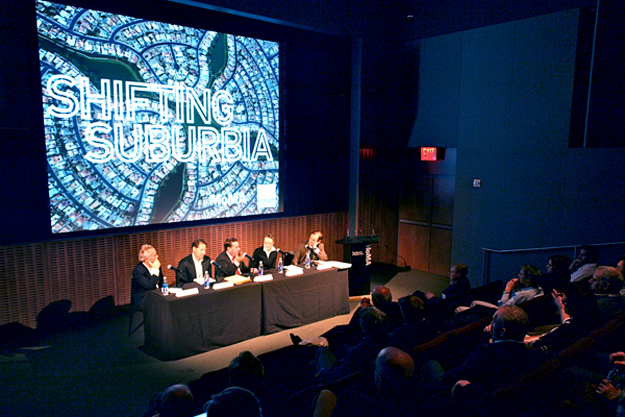'Shifting Suburbia,' a recent panel discussion organized by the Forum for Urban Design, brings visionary thinking down to earth.
 |
| Photo © Daniel McPhee/courtesy Forum for Urban Design |
| During a recent panel, two developers, an architecture professor, and a real estate lawyer reacted soberly to the adventurous and optimistic schemes presented in MoMA's current exhibition, Foreclosed: Rehousing the American Dream. MoMA's Barry Bergdoll moderated the discussion. |
Last summer, six teams of architects of architects, economists, public policy experts, and housing advocates started developing schemes for re-generating old suburbs in the face of the foreclosure crisis. And in February, an exhibition of elaborate models, videos and descriptions of their dramatic ideas opened at the Museum of Modern Art.
But during a panel on March 8 at the museum sponsored by the Forum for Urban Design, two developers, an architecture professor, and a real estate lawyer reacted soberly to the adventurous and optimistic schemes. Though the panelists agreed that the foreclosure crisis will lead to major changes in suburban development, they all thought new patterns are less likely to be brought about by a revised American dream than by economic and demographic factors. And all said it would be very difficult to change zoning laws to permit denser new development patterns, especially in existing “inner-ring” suburbs.
During the lively discussion that evening, two types of sites did emerge as possible opportunities for dense development: abandoned big box stores, like the one WORKac had proposed to reuse in Keizer, Oregon, and golf courses, which were overbuilt during the boom.
Here are some key comments from the participants.
Ara K. Hovnanian, CEO of Hovnanian Enterprises, a national builder of single-family and multi-family housing.
“The downturn has forced us to be more creative, because there are so many properties on the market for less than we could build them.” Land costs are lower today, but new construction “has to differentiate itself to be competitive.” One new product is “the multi-generational and multi-household house” which can accommodate “boomerang children, aging parents, and older siblings teaming up.” These “homes within a home” have separate entrances but are connected inside. They would be allowed in many areas restricted to single-family homes. But they could not be built in those that limit the number of bathrooms or bedrooms.
Joseph Rose, former chairman of the New York City Planning Commission and a partner in the Georgetown Company, a developer of office, residential, and recreational properties across the country.
Because of recent demographic and economic changes, “higher density is becoming viable,” but “it is easier to do this on open land” rather than in older suburbs because of difficulty in re-zoning. He believes that “merging avant-garde design and higher densities,” like those depicted in most of the schemes in the MoMA show, “can work at cross purposes.”
Grady Gammage, Jr., real estate lawyer and fellow at Arizona State University’s Morrison Institute.
“Cities change in increments.” In the future, “people won’t be able to afford what they had in the past. That is going to drive density—there will be smaller and smaller lots.” But he doesn’t think the transit-oriented development promoted in the show will come to Phoenix. “You cannot retrofit a place that was entirely built for the auto.” Even high gas prices will not change driving habits, at least until gas costs $10 a gallon, one of his client’s studies showed.
Ellen Dunham-Jones, a professor of architecture at Georgia Tech and board member of the Congress for the New Urbanism.
She advocates transit-oriented development. “Market studies show that 30 percent of the population is unhappy with what the market offers,” but you can’t really change options until you modify the laws that created suburban development as we know it. “Change the regulatory structure and you change the city.”

Post a comment to this article
Report Abusive Comment